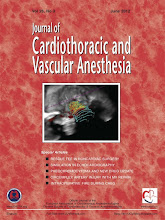Feroze Mahmood,MD
Madhav Swaminathan, MD
Section Editors
An Incidental Finding During Emergent Vascular Surgery: How Far to Go?
Shanaz Ali, MD, Omair Shakil, MD, Tzong-Huei Chen, MD, Haider Javed Warraich, MD, and Robina Matyal, MD
Department of Anesthesia, Critical Care and Pain Medicine, Beth Israel Deaconess Medical Center, Boston, MA
Address reprint requests to Shanaz Ali, MD, Department of Anesthesia, Critical Care and Pain Medicine, Beth Israel Deaconess Medical Center, One Deaconess Road, CC-470, Boston, MA 02215. E-mail: seali@bidmc.harvard.eduKey words: Amplatzer device, transesophageal echocardiography, intracardiac thrombus
A 40-YEAR-OLD MAN presented to the authors' tertiary care center with an acute onset of pain in his left foot. He was otherwise hemodynamically stable, alert, and oriented. His past medical history was significant for multiple strokes and pulmonary emboli. On a previous admission for stroke workup 5 years earlier, he had a transthoracic echocardiogram that revealed an atrial septal defect (ASD). The defect was closed percutaneously with an Amplatzer device (AGA Medical Corporation, Plymouth, MN). Since the closure of the ASD, the patient had been free of embolic events. A physical examination in the emergency room revealed no palpable pulses in the
Figue 1. Two-dimensional transesophageal echocardiogram: The midesophageal 4-chamber view showing the Amplatzer device in the interatrial septum with 2 clots in the left atrium.
Fig 2. Three-dimensional transesophageal echocardiogram: the view throught the left atrial perspective of the mitral valve showing the Amplatzer device in the interatrial septum, with one clot attached to the inferior portion of the device and the smaller clot attached to the posterior wall of the left atrium. (Color version of figure is available online.)
After an uneventful induction of general anesthesia, based on his history of multiple embolic events, the presence of an intracardiac device, and acute limb ischemia, a transesophageal echocardiographic (TEE) examination was performed using an IE-33 Ultrasound System Omni-III TEE Probe (Philips Medical Systems, Andover, MA).
Echocardiographic Findings
Figure 3. (A) The Amplatzer device after removal from the patient. (B) Clots removed from the left atrium. (Color version of figure is available online.)
Echocardiographic Challenge
Clinical Challenge
1. After establishing the presence of thrombi in the left atrium, the risk of embolization in the patient needed to be determined. Based on the patient's presentation and echocardiographic appearance of the thrombi (pedunculated and freely mobile), it was determined that the risk of embolization was significant.
2. The second challenge was whether to proceed to emergent cardiac surgery during the same anesthestic versus obtaining informed consent and proceeding urgently the following day. Would obtaining informed consent and delaying cardiac surgery place the patient at an increased risk for a catastrophic embolic event?
Intraoperative Decision
After discussion with the cardiac and vascular surgery teams, it was decided that the patient would require removal of the thrombi along with the possible removal of the Amplatzer device under cardiopulmonary bypass. The situation was discussed with the patient's next-of-kin, and it was decided to place the patient on a therapeutic heparin drip and proceed with cardiac surgery after obtaining informed consent. The patient was brought back to the operating room the next morning. After the initiation of cardiopulmonary bypass, the left atrium was opened, and two large thrombi were removed, one attached to the inferior aspect of the ASD closure device and the other attached to the posterior aspect of left atrium near the mitral valve annulus (Fig 3). The ASD closure device was removed and the defect closed with a core matrix patch. The patient had an uneventful postoperative recovery. A thorough workup was ordered to investigate the possibility of a hypercoagulable disorder, and the patient was found to have protein S and factor X deficiency. Subsequently, the patient was discharged with a prescription for coumadin in therapeutic doses.




